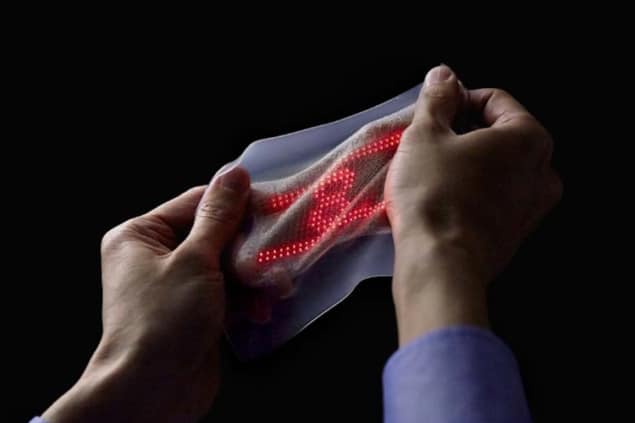
A new breathable and flexible on-skin sensor containing an array of light-emitting diodes embedded in a thin rubber sheet can display the moving waveform of an electrocardiogram. This information can then be wirelessly communicated. The device, which is easy to use, might be used in health monitoring applications for self-care in the home.
Wearable and flexible electronics have come along in leaps and bounds in the last few years with devices like biomedical electronic patches and electronic skin that can now monitor vital signs or take an electrocardiogram. These measurements can then be wirelessly sent to a smartphone or computer and be displayed in real time. They can also be sent to the cloud or to a memory device and be stored.
The new device was made by Takao Someya and colleagues at the University of Tokyo’s Graduate School of Engineering and researchers at Dai Nippon Printing. It consists of a 16 × 24 array of 630 nm wavelength (red) commercially-available LEDs and stretchable wiring embedded in a rubber sheet and is just 1 mm thick in total. It is far more robust to stretching than previous such wearable displays thanks to it being built on a novel structure that minimizes the stress resulting from stretching as it is worn.
Buckling helps
“We began by printing stretchable silver pastes on ultrathin plastic foils, which we then laminated with pre-stretched rubber substrates,” explains Someya. “When the substrates relax after the pre-stretching step, buckling structures can form. This buckling helps minimize stress resulting from stretching on the junction between the hard material (the LEDs) and the soft material (the elastic wiring). This stress was one of the reasons for device damage and failure in the past.”
The device can be continuously worn on the skin for a week without causing any irritation, he adds, and is stable in air.
“Although we previously used this sensor to measure temperature, pressure and myoelectricity (the electrical properties of muscles), we were able to take an electrocardiogram for the first time with it.
“And while the current display is connected to a small rigid box that contains batteries, memory and a driving circuit, we will be miniaturizing the box in the near future and connecting it to Wifi,” he tells nanotechweb.org.
Towards commercialization
Indeed, Dai Nippon Printing says that it would like the commercialize the device within the next three years by optimizing its structure and improving the production process. “The fact that we employed techniques widely used in the electronics industry – namely, screen printing the silver wiring and mounting the LEDs on the rubber sheet with a chip mounter and solder paste (routinely used in manufacturing printing boards) – will likely help overcome technical challenges such as large-area coverage,” says Someya.
“We believe that the device might come in particularly useful for the elderly or infirm, because it easy to use,” he adds.” It could be used as a wearable sensor to monitor patient vital signs and so reduce the burden on hospitals and nursing homes by proving at-home care. This should ultimately improve the quality of life for many.”
The research was presented at a news briefing and talk at the AAAS Annual Meeting in Austin, Texas.



